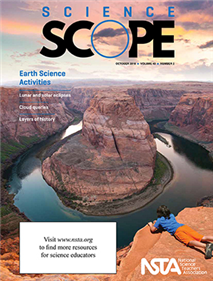All Science Scope resources
Journal Article
The Four Strands of Science Learning and the Next Generation Science Standards
How you can create greater proficiency in your middle school classroom....
Journal Article
Teacher's Toolkit: Puzzle Boxes for 3-D Learning About Natural Hazards
This column provides how-to strategies and practical advice for the science teacher. In this month’s issue the author describes how he has modified his toy blocks and cubes lessons to introduce students to the nature of scientific research to have ...
Journal Article
Classic Lessons 2.0: Using Multiple Representations to Teach Science
This column shares updated perennial classroom favorites. This article demonstrates how teachers can use six major steps of using multiple representations to teach a difficult scientific concept, Moon phases, which many middle school students struggl...
Journal Article
Citizen Science: Clouds in the Classroom
This column highlights formal and informal science research projects that students can join and contribute to by gathering and sharing data. With Students’ Cloud Observations On-Line (S’COOL), you can bring the science of the skies to your classr...
Journal Article
Disequilibrium: Forming Clouds in the Classroom
This column shows how to use discrepant events to confront misconceptions. This month’s discrepant event allows students to model condensation, the portion of the hydrologic cycle in which water vapor condenses into liquid form and creates a cloud....
Journal Article
Teacher to Teacher: Phenomenal Engagement
This column provides practical advice from your peers. One way to engage middle school students is through the use of relevant scientific phenomena. A scientific phenomenon is something (such as an interesting fact or event) that can be observed and ...
Journal Article
Listserv Roundup: Finding and Saving Earth Science Resources
This column shares recent conversations taken from the NSTA listserv community about current science education topics. Learn about Earth science resources on NSTA e-mail listservs where there is an abundance of teacher-shared materials and websites r...
Journal Article
Science for All: Literacy Engagement and Its Role in the Science Classroom
This column shares strategies for increasing student engagement. This month's issues describes how to choose content-area reading materials with purpose....
Journal Article
Scope on the Skies: Connected Computing
This column focuses on astronomy throughout the year. This month’s issue discusses how students can partake in scientific research through distributed computing, where the computing for a research project is done on a network of computers in diffe...


